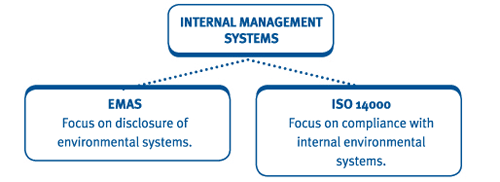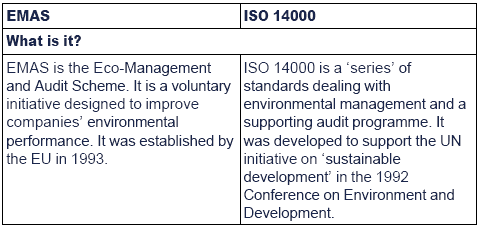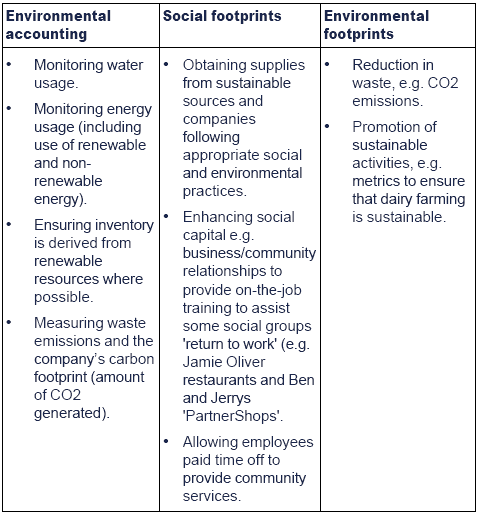Corporate social responsibility and management systems
People and business has become more environmentally-friendly in recent years. Products, systems, transport and buildings are now designed to minimise their impact on the world.
The challenge for businesses is to make their operations more sustainableand to reduce their environmental impact. This can only be done if the business has management systems that allow the impact of operations to be monitored and controlled.
Management systems

Environmental accounting relates to the need to establish and maintain systems for assessing the organisation's impact on the environment.
EMAS and ISO 14000 are both systems that support the establishment and maintenance of environmental accounting systems.
Many companies refer to the standards in their CSR reports.
Eco-Management and Audit Scheme (EMAS)
EMAS is the Eco-Management and Audit Scheme. It is a voluntary initiative designed to improve companies' environmental performance.
- EMAS requires participating organisations to regularly produce a public environmental statement that reports on their environmental performance.
- Accuracy and reliability is independently checked by an environmental verifier to give credibility and recognition to that information.
- EMAS requires participating organisations to implement an environmental management system (EMS).
- There are four key elements of the scheme:
- Legal requirement
- Dialogue/reporting
- Improved environmental performance
- Employee involvement.
ISO14000
ISO14000 is a series of standards dealing with environmental management and a supporting audit programme.
- The ISO formulates the specifications for an EMS.
- EMAS compliance is based on ISO 14000 recognition - although many organisations comply with both standards.
- ISO 14000 focuses on internal systems although it also provides assurance to stakeholders of good environmental management.
- To gain accreditation an organisation must meet a number of requirements regarding its environmental management.




Benefits of compliance with either standard
Reduced cost of waste management.
- Savings in consumption of energy and materials.
- Lower distribution costs.
- Improved corporate image among regulators, customers and the public.
- Framework for continuous improvement of the companies' environmental performance.
Social and environmental audit
Social auditing
A process that enables an organisation to assess and demonstrate its social, economic, and environmental benefits and limitations.
- Also measures the extent to which an organisation achieves the shared values and objectives set out in its mission statement.
- Provides the process for environmental auditing.
Elements of a social audit
External view
Obtain the view of external stakeholders to form a view of the organisation's position within the wider context.
Internal view
Obtain views of the board of directors, staff and volunteers to assess satisfactory ways of working and reward. This helps to ensure that organisational management and systems can achieve the stated purpose and plans.
Review and planning
The social audit team manages the social audit and measures performance ready for input into next year's social audit.
The concept of social audit is to provide additional information on a company's activities over and above the financial accounts. In this sense it has links with TBL and FCA. The main difference in a social audit is the active involvement of external stakeholders, and in many situations the publication of a social audit by those external stakeholders. For example, one company, Social Audit Ltd, provides social audits on companies, sometimes without the active participation of the companies.
Typical sections of a social audit report include:
- an overview of the company including salient features of the financial accounts
- the company's stance regarding employees such as how pay and benefits are negotiated, provision of job security and policies on discrimination in the areas of sex, race and disabilities
- overview of products with negative environmental impacts
- the environmental impact of the company itself in terms of pollution, emissions, recycling, etc. and health and safety policies
- the social impact of the company in terms of community support
- response, if any, from the company.
In effect, the social audit is evaluating the organisation's footprint (social, environmental, etc.) within a given accounting period from the external perspective.
Environmental auditing
Aims to assess the impact of the organisation on the environment.
- Normally involves the implementation of appropriate environmental standards such as ISO 14001 and EMAS.
- Provides the raw data for environmental accounting.
- An environmental audit typically contains three elements:
- agreed metrics (what should be measured and how)
- performance measured against those metrics
- reporting on the levels of compliance or variance.
An environmental audit leads into an environmental action plan.
The audit is based on the implementation of the appropriate environmental standards, e.g. ISO 14001 or EMAS.
The main areas to cover within the environment audit normally include:
- waste management and waste minimisation
- emissions to air
- ground and groundwater protection
- surface water management
- energy and utility consumption
- environmental emergencies
- protection of environmentally sensitive areas
- product/service stewardship
- management of contractors control of visitors
- local issues.
Environmental accounting
This is the development of an environmental accounting system to support the integration of environmental performance measures.
- It builds on social and environmental auditing by providing empirical evidence of the achievement of social and environmental objectives.
- Without social and environmental auditing, environmental accounting would not be possible.
The aims of environmental accounting are:
- to use the metrics produced from an environmental audit and incorporate these into an environmental report, and
- to integrate environmental performance measures into core financial processes to generate cost savings and reduce environmental impact through improved management of resources.
Definition: 'to develop an environmental accounting system to support the integration of environmental performance measures into our core financial processes, and to track internal environmentally significant expenditure' (Environmental Policy Statement 12 July 2000) issued by the UK Environment Agency.
Benefits of environmental accounting
Cost savings
To utilise resources efficiently and effectively, and in doing so generate cost savings.
Environmental improvements
To support the delivery of the environmental audit which will benefit the company and the environment – see above for a list of those areas involved with environmental audit.
Corporate governance
To assist in the management of environmental risks and operational costs including the publication of environmental accounting disclosures in corporate documents such as the annual and CSR reports.
To assist in the management of environmental risks and operational costs including the publication of environmental accounting disclosures in corporate documents such as the annual and CSR reports. Examples of measuring impact on environment

Mass balance
Environmental accounting can also be explained in terms of the 'mass balance'. This system shows what inputs (that is materials) have been converted into finished goods as well as emissions and recyclable waste products. In effect, the mass balance shows the inputs to a production process in weight terms compared to the outputs produced. The aim is to minimise inputs and non-recyclable outputs.
|
Created at 10/2/2012 3:19 PM by System Account
(GMT) Greenwich Mean Time : Dublin, Edinburgh, Lisbon, London
|
Last modified at 9/27/2013 3:32 PM by System Account
(GMT) Greenwich Mean Time : Dublin, Edinburgh, Lisbon, London
|
|
|
|
 |
Rating
:
|
 Ratings & Comments
(Click the stars to rate the page) Ratings & Comments
(Click the stars to rate the page)
|
 |
Tags:
|
|
|
|
|